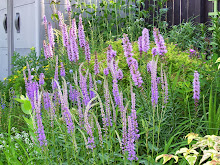 |
| Barberry, on the left, are a common shrub in many central WI foundation plantings. |
In an area where it seems more often than not that the USDA's horticultural zone chart is a big lie, where extremes in weather are the norms not the abnormalities, and where a broad base of plants which are "tried and true" is a dream more than reality; this latest news just sucks.
Between invasives other undesirable herbaceous plants, planting could get pretty thin here. We have lost a lot of our white pines in The Drought of 2012 and The Brutal Winter of 2013. My garden is in recovery mode. Slight snow cover and a very cold drop in temperatures this past winter again tested the hardiness of many plants in my garden. My one privet hedge is very much in recovery. I lost a Sweet Autumn clematis (who can kill an established Sweet Autumn?) Roses of all sorts beyond rugosas and the native wild rose and rosa carolina, have taken a hard hit. Arborvitae are nothing more than deer browse. Spruce and spruce tip blight are nearly synonymous here in the village.
So my sister from PA visits. She is much more wired in to east coast research than I. She tells me about this latest UConn study. There are 40% more black legged deer ticks in areas of uncontrolled barberry (Japanese-- thunbergii) than in areas where there are no barberry. In areas, where the growth of barberry are controlled (foundation planting in landscaped areas). there are a quarter as many as uncontrolled, but significantly more than in areas where there are no barberry.
Now, barberry are not browsed by deer, but loved by mice who like to gnaw on them throughout the winter months. Barberry also do better with a bit more moisture. Ticks like moisture. It is easy to see where ticks, mice, barberries, deer and Lyme disease begin to all share the same habitat are are part of the same nature web.
Barberries are spread by birds making them invasive. It is easy to see where an increase in deer population and their increasing incursions into urban areas has aided Lyme disease and its spread.
Put another "tick" mark in the "bad" column for ornamental barberries.





























